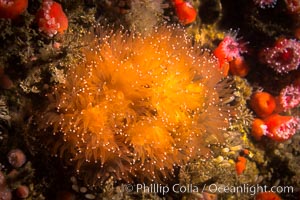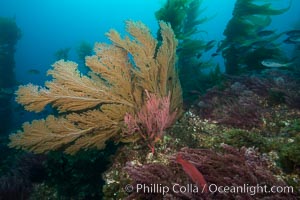
California golden gorgonian on underwater rocky reef below kelp forest, San Clemente Island. The golden gorgonian is a filter-feeding temperate colonial species that lives on the rocky bottom at depths between 50 to 200 feet deep. Each individual polyp is a distinct animal, together they secrete calcium that forms the structure of the colony. Gorgonians are oriented at right angles to prevailing water currents to capture plankton drifting by, San Clemente Island. The golden gorgonian is a filter-feeding temperate colonial species that lives on the rocky bottom at depths between 50 to 200 feet deep. Each individual polyp is a distinct animal, together they secrete calcium that forms the structure of the colony. Gorgonians are oriented at right angles to prevailing water currents to capture plankton drifting by.
Species: California golden gorgonian, Muricea californica
Location: San Clemente Island, California
Image ID: 30893
Species: California golden gorgonian, Muricea californica
Location: San Clemente Island, California
Image ID: 30893
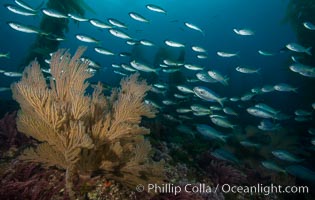
Blacksmith Chromis and California golden gorgonian on underwater rocky reef, San Clemente Island. The golden gorgonian is a filter-feeding temperate colonial species that lives on the rocky bottom at depths between 50 to 200 feet deep. Each individual polyp is a distinct animal, together they secrete calcium that forms the structure of the colony. Gorgonians are oriented at right angles to prevailing water currents to capture plankton drifting by.
Species: Blacksmith, California golden gorgonian, Chromis punctipinnis, Muricea californica
Location: San Clemente Island, California
Image ID: 30894
Species: Blacksmith, California golden gorgonian, Chromis punctipinnis, Muricea californica
Location: San Clemente Island, California
Image ID: 30894

Colony of Pelicans resting at sunrise on La Jolla Cliffs. Rough iPhone panorama.
Species: Brown Pelican, Pelecanus occidentalis, Pelecanus occidentalis californicus
Location: La Jolla, California
Image ID: 36723
Panorama dimensions: 3415 x 12978
Species: Brown Pelican, Pelecanus occidentalis, Pelecanus occidentalis californicus
Location: La Jolla, California
Image ID: 36723
Panorama dimensions: 3415 x 12978
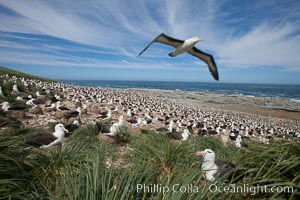
Black-browed albatross in flight, over the enormous colony at Steeple Jason Island in the Falklands.
Species: Black-browed albatross, Thalassarche melanophrys
Location: Steeple Jason Island, Falkland Islands, United Kingdom
Image ID: 24077
Species: Black-browed albatross, Thalassarche melanophrys
Location: Steeple Jason Island, Falkland Islands, United Kingdom
Image ID: 24077
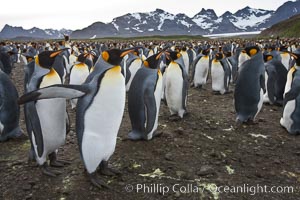
King penguin colony. Over 100,000 pairs of king penguins nest at Salisbury Plain, laying eggs in December and February, then alternating roles between foraging for food and caring for the egg or chick.
Species: King penguin, Aptenodytes patagonicus
Location: Salisbury Plain, South Georgia Island
Image ID: 24388
Species: King penguin, Aptenodytes patagonicus
Location: Salisbury Plain, South Georgia Island
Image ID: 24388
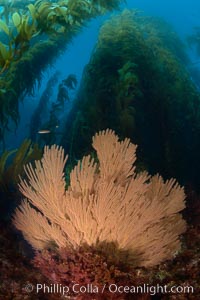
California golden gorgonian on rocky reef, below kelp forest, underwater. The golden gorgonian is a filter-feeding temperate colonial species that lives on the rocky bottom at depths between 50 to 200 feet deep. Each individual polyp is a distinct animal, together they secrete calcium that forms the structure of the colony. Gorgonians are oriented at right angles to prevailing water currents to capture plankton drifting by.
Species: California golden gorgonian, Macrocystis pyrifera, Muricea californica
Location: San Clemente Island, California
Image ID: 23439
Species: California golden gorgonian, Macrocystis pyrifera, Muricea californica
Location: San Clemente Island, California
Image ID: 23439
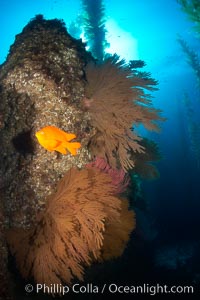
Garibaldi and California golden gorgonians on rocky reef, below kelp forest, underwater. The golden gorgonian is a filter-feeding temperate colonial species that lives on the rocky bottom at depths between 50 to 200 feet deep. Each individual polyp is a distinct animal, together they secrete calcium that forms the structure of the colony. Gorgonians are oriented at right angles to prevailing water currents to capture plankton drifting by.
Species: California golden gorgonian, Hypsypops rubicundus, Muricea californica
Location: San Clemente Island, California
Image ID: 23443
Species: California golden gorgonian, Hypsypops rubicundus, Muricea californica
Location: San Clemente Island, California
Image ID: 23443
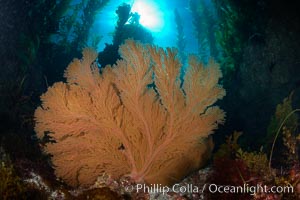
California golden gorgonian on rocky reef, below kelp forest, underwater. The golden gorgonian is a filter-feeding temperate colonial species that lives on the rocky bottom at depths between 50 to 200 feet deep. Each individual polyp is a distinct animal, together they secrete calcium that forms the structure of the colony. Gorgonians are oriented at right angles to prevailing water currents to capture plankton drifting by.
Species: California golden gorgonian, Macrocystis pyrifera, Muricea californica
Location: San Clemente Island, California
Image ID: 23445
Species: California golden gorgonian, Macrocystis pyrifera, Muricea californica
Location: San Clemente Island, California
Image ID: 23445
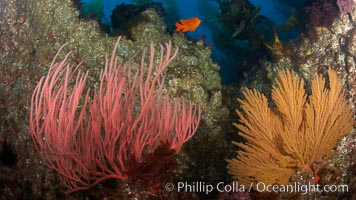
Red gorgonian (left) and California golden gorgonian (right) on rocky reef, below kelp forest, underwater. Gorgonians are filter-feeding temperate colonial species that live on the rocky bottom at depths between 50 to 200 feet deep. Each individual polyp is a distinct animal, together they secrete calcium that forms the structure of the colony. Gorgonians are oriented at right angles to prevailing water currents to capture plankton drifting by.
Species: Red gorgonian, Leptogorgia chilensis, Lophogorgia chilensis
Location: San Clemente Island, California
Image ID: 23452
Species: Red gorgonian, Leptogorgia chilensis, Lophogorgia chilensis
Location: San Clemente Island, California
Image ID: 23452
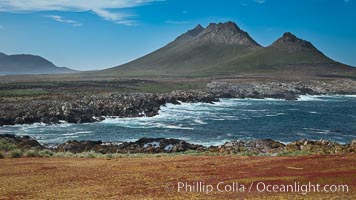
Steeple Jason Island, southwestern exposure, looking south pass the isthmus toward the southern half of the island. Steeple Jason is one of the remote Jason Group of Islands in the West Falklands. Uninhabited, the island is spectacular both for its rugged scenery and its enormous breeding colony of black-browed albatross. Steeple Jason Island is now owned and administered by the Wildlife Conservation Society.
Location: Steeple Jason Island, Falkland Islands, United Kingdom
Image ID: 24085
Location: Steeple Jason Island, Falkland Islands, United Kingdom
Image ID: 24085
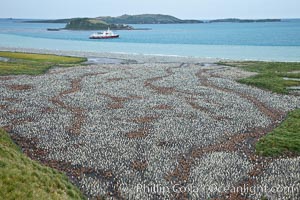
King penguin colony and the Bay of Isles on the northern coast of South Georgia Island. Over 100,000 nesting pairs of king penguins reside here. Dark patches in the colony are groups of juveniles with fluffy brown plumage. The icebreaker M/V Polar Star lies at anchor.
Species: King penguin, Aptenodytes patagonicus
Location: Salisbury Plain, South Georgia Island
Image ID: 24383
Species: King penguin, Aptenodytes patagonicus
Location: Salisbury Plain, South Georgia Island
Image ID: 24383
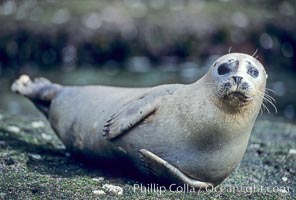
A Pacific harbor seal hauls out on a rock. This group of harbor seals, which has formed a breeding colony at a small but popular beach near San Diego, is at the center of considerable controversy. While harbor seals are protected from harassment by the Marine Mammal Protection Act and other legislation, local interests would like to see the seals leave so that people can resume using the beach.
Species: Pacific harbor seal, Phoca vitulina richardsi
Location: La Jolla, California
Image ID: 03010
Species: Pacific harbor seal, Phoca vitulina richardsi
Location: La Jolla, California
Image ID: 03010
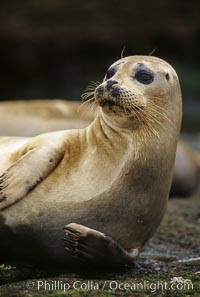
A Pacific harbor seal hauls out on a rock. This group of harbor seals, which has formed a breeding colony at a small but popular beach near San Diego, is at the center of considerable controversy. While harbor seals are protected from harassment by the Marine Mammal Protection Act and other legislation, local interests would like to see the seals leave so that people can resume using the beach.
Species: Pacific harbor seal, Phoca vitulina richardsi
Location: La Jolla, California
Image ID: 03011
Species: Pacific harbor seal, Phoca vitulina richardsi
Location: La Jolla, California
Image ID: 03011
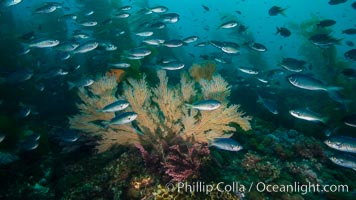
Blacksmith Chromis and California golden gorgonian on underwater rocky reef, San Clemente Island. The golden gorgonian is a filter-feeding temperate colonial species that lives on the rocky bottom at depths between 50 to 200 feet deep. Each individual polyp is a distinct animal, together they secrete calcium that forms the structure of the colony. Gorgonians are oriented at right angles to prevailing water currents to capture plankton drifting by.
Species: Blacksmith, California golden gorgonian, Chromis punctipinnis, Muricea californica
Location: San Clemente Island, California
Image ID: 30905
Species: Blacksmith, California golden gorgonian, Chromis punctipinnis, Muricea californica
Location: San Clemente Island, California
Image ID: 30905
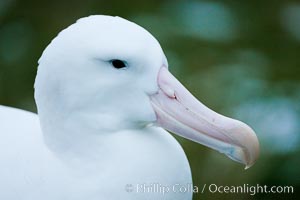
Wandering albatross, on nest and the Prion Island colony. The wandering albatross has the largest wingspan of any living bird, with the wingspan between, up to 12' from wingtip to wingtip. It can soar on the open ocean for hours at a time, riding the updrafts from individual swells, with a glide ratio of 22 units of distance for every unit of drop. The wandering albatross can live up to 23 years. They hunt at night on the open ocean for cephalopods, small fish, and crustaceans. The survival of the species is at risk due to mortality from long-line fishing gear.
Species: Wandering albatross, Diomedea exulans
Location: Prion Island, South Georgia Island
Image ID: 24385
Species: Wandering albatross, Diomedea exulans
Location: Prion Island, South Georgia Island
Image ID: 24385
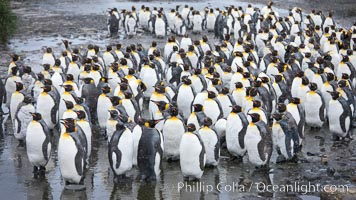
King penguin colony at Salisbury Plain, Bay of Isles, South Georgia Island. Over 100,000 pairs of king penguins nest here, laying eggs in December and February, then alternating roles between foraging for food and caring for the egg or chick.
Species: King penguin, Aptenodytes patagonicus
Location: Salisbury Plain, South Georgia Island
Image ID: 24431
Species: King penguin, Aptenodytes patagonicus
Location: Salisbury Plain, South Georgia Island
Image ID: 24431
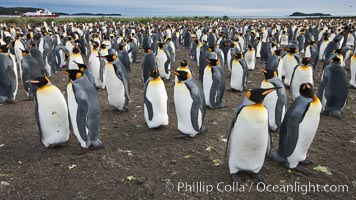
King penguin colony. Over 100,000 pairs of king penguins nest at Salisbury Plain, laying eggs in December and February, then alternating roles between foraging for food and caring for the egg or chick.
Species: King penguin, Aptenodytes patagonicus
Location: Salisbury Plain, South Georgia Island
Image ID: 24456
Species: King penguin, Aptenodytes patagonicus
Location: Salisbury Plain, South Georgia Island
Image ID: 24456
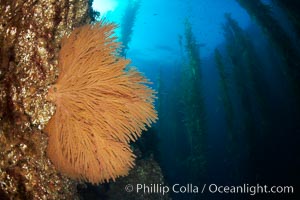
California golden gorgonian on rocky reef, below kelp forest, underwater. The golden gorgonian is a filter-feeding temperate colonial species that lives on the rocky bottom at depths between 50 to 200 feet deep. Each individual polyp is a distinct animal, together they secrete calcium that forms the structure of the colony. Gorgonians are oriented at right angles to prevailing water currents to capture plankton drifting by.
Species: California golden gorgonian, Macrocystis pyrifera, Muricea californica
Location: San Clemente Island, California
Image ID: 23477
Species: California golden gorgonian, Macrocystis pyrifera, Muricea californica
Location: San Clemente Island, California
Image ID: 23477
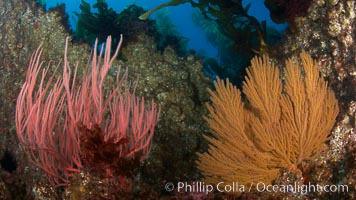
Red gorgonian (left) and California golden gorgonian (right) on rocky reef, below kelp forest, underwater. Gorgonians are filter-feeding temperate colonial species that live on the rocky bottom at depths between 50 to 200 feet deep. Each individual polyp is a distinct animal, together they secrete calcium that forms the structure of the colony. Gorgonians are oriented at right angles to prevailing water currents to capture plankton drifting by.
Species: Red gorgonian, Leptogorgia chilensis, Lophogorgia chilensis
Location: San Clemente Island, California
Image ID: 23509
Species: Red gorgonian, Leptogorgia chilensis, Lophogorgia chilensis
Location: San Clemente Island, California
Image ID: 23509
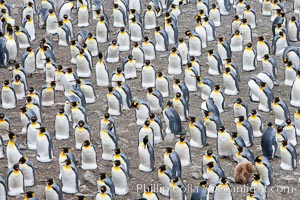
King penguin colony. Over 100,000 pairs of king penguins nest at Salisbury Plain, laying eggs in December and February, then alternating roles between foraging for food and caring for the egg or chick.
Species: King penguin, Aptenodytes patagonicus
Location: Salisbury Plain, South Georgia Island
Image ID: 24386
Species: King penguin, Aptenodytes patagonicus
Location: Salisbury Plain, South Georgia Island
Image ID: 24386
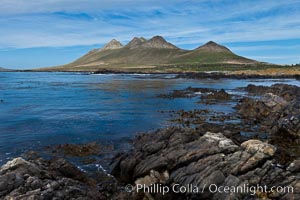
Northeastern coast of Steeple Jason Island, looking toward the southern half of the island. Steeple Jason is one of the remote Jason Group of Islands in the West Falklands. Uninhabited, the island is spectacular both for its rugged scenery and its enormous breeding colony of black-browed albatross. Steeple Jason Island is now owned and administered by the Wildlife Conservation Society.
Location: Steeple Jason Island, Falkland Islands, United Kingdom
Image ID: 24101
Location: Steeple Jason Island, Falkland Islands, United Kingdom
Image ID: 24101
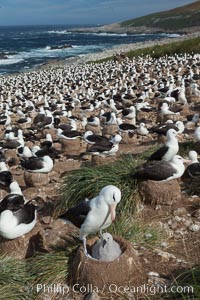
Black-browed albatross colony on Steeple Jason Island in the Falklands. This is the largest breeding colony of black-browed albatrosses in the world, numbering in the hundreds of thousands of breeding pairs. The albatrosses lay eggs in September and October, and tend a single chick that will fledge in about 120 days.
Species: Black-browed albatross, Thalassarche melanophrys
Location: Steeple Jason Island, Falkland Islands, United Kingdom
Image ID: 24122
Species: Black-browed albatross, Thalassarche melanophrys
Location: Steeple Jason Island, Falkland Islands, United Kingdom
Image ID: 24122
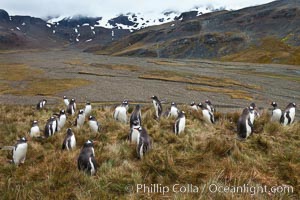
Gentoo penguins, permanent nesting colony in grassy hills about a mile inland from the ocean, near Stromness Bay, South Georgia Island.
Species: Gentoo penguin, Pygoscelis papua
Location: Stromness Harbour, South Georgia Island
Image ID: 24586
Species: Gentoo penguin, Pygoscelis papua
Location: Stromness Harbour, South Georgia Island
Image ID: 24586
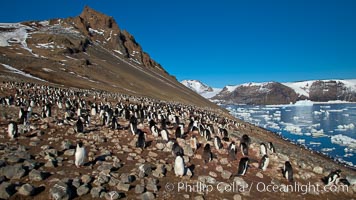
Adelie penguins at the nest, part of the large nesting colony of penguins that resides along the lower slopes of Devil Island.
Species: Adelie penguin, Pygoscelis adeliae
Location: Devil Island, Antarctic Peninsula, Antarctica
Image ID: 25013
Species: Adelie penguin, Pygoscelis adeliae
Location: Devil Island, Antarctic Peninsula, Antarctica
Image ID: 25013
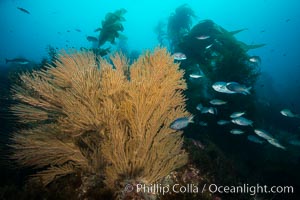
Blacksmith Chromis and California golden gorgonian on underwater rocky reef, San Clemente Island. The golden gorgonian is a filter-feeding temperate colonial species that lives on the rocky bottom at depths between 50 to 200 feet deep. Each individual polyp is a distinct animal, together they secrete calcium that forms the structure of the colony. Gorgonians are oriented at right angles to prevailing water currents to capture plankton drifting by.
Species: Blacksmith, California golden gorgonian, Chromis punctipinnis, Muricea californica
Location: San Clemente Island, California
Image ID: 30866
Species: Blacksmith, California golden gorgonian, Chromis punctipinnis, Muricea californica
Location: San Clemente Island, California
Image ID: 30866
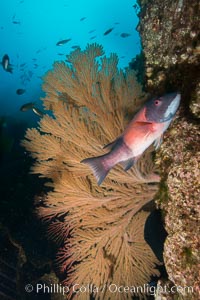
California golden gorgonian and Sheephead wrasse fishes on rocky reef, below kelp forest, underwater. The golden gorgonian is a filter-feeding temperate colonial species that lives on the rocky bottom at depths between 50 to 200 feet deep. Each individual polyp is a distinct animal, together they secrete calcium that forms the structure of the colony. Gorgonians are oriented at right angles to prevailing water currents to capture plankton drifting by.
Species: California sheephead wrasse, Semicossyphus pulcher
Location: San Clemente Island, California
Image ID: 30888
Species: California sheephead wrasse, Semicossyphus pulcher
Location: San Clemente Island, California
Image ID: 30888
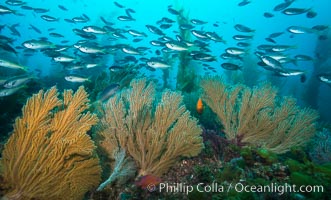
Blacksmith Chromis and California golden gorgonian on underwater rocky reef, San Clemente Island. The golden gorgonian is a filter-feeding temperate colonial species that lives on the rocky bottom at depths between 50 to 200 feet deep. Each individual polyp is a distinct animal, together they secrete calcium that forms the structure of the colony. Gorgonians are oriented at right angles to prevailing water currents to capture plankton drifting by.
Species: Blacksmith, California golden gorgonian, Chromis punctipinnis, Muricea californica
Location: San Clemente Island, California
Image ID: 30892
Species: Blacksmith, California golden gorgonian, Chromis punctipinnis, Muricea californica
Location: San Clemente Island, California
Image ID: 30892
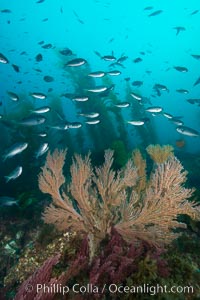
Blacksmith Chromis and California golden gorgonian on underwater rocky reef, San Clemente Island. The golden gorgonian is a filter-feeding temperate colonial species that lives on the rocky bottom at depths between 50 to 200 feet deep. Each individual polyp is a distinct animal, together they secrete calcium that forms the structure of the colony. Gorgonians are oriented at right angles to prevailing water currents to capture plankton drifting by.
Species: Blacksmith, California golden gorgonian, Chromis punctipinnis, Muricea californica
Location: San Clemente Island, California
Image ID: 30906
Species: Blacksmith, California golden gorgonian, Chromis punctipinnis, Muricea californica
Location: San Clemente Island, California
Image ID: 30906
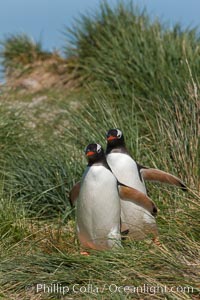
Gentoo penguins walk through tussock grass. After foraging in the ocean for food, the penguins make their way to the interior of the island to rest at their colony.
Species: Gentoo penguin, Pygoscelis papua
Location: Carcass Island, Falkland Islands, United Kingdom
Image ID: 23970
Species: Gentoo penguin, Pygoscelis papua
Location: Carcass Island, Falkland Islands, United Kingdom
Image ID: 23970
